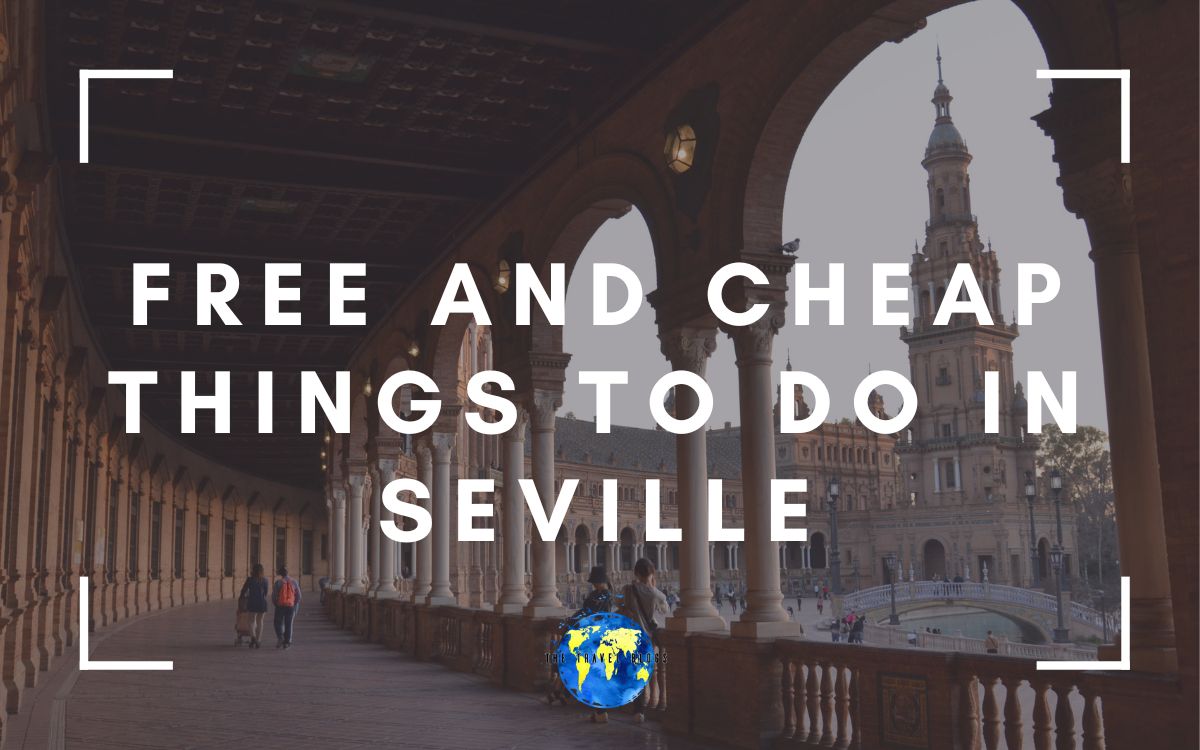With its sun-drenched plazas and ornate Moorish architecture, Seville, the heart of Andalusia, surprises you with its affordability. If you know where to look, a wealth of rich experiences await, ranging from the passionate twirls of flamenco to intriguing modern art installations, all without breaking the bank.
My many journeys through the winding alleyways of this charming city have led me to create a handpicked selection of the most fascinating yet cheap activities in Seville. Each activity offers a taste of the city’s vibrant culture, a nod to its layered history, and shares a story of the spirited locals.
Get ready to immerse yourself in the rhythm and warmth of Seville, a city in southern Spain that has mastered the art of living well, even on a shoestring budget. The rich blend of tradition and innovation that thrives in its streets ensures that every moment here is unforgettable.
Dive into my curated list of the city’s top ten cheap (sometimes free) activities. Some open their doors for free every day, while others invite you in without charge on certain weekdays.
Before you visit – check out my top helpful travel resources
Here are a few of my recommendations for travel assistance and sites I use when traveling myself. For more on these and why I choose to recommend them, check out my full disclosure page.
- Book your travel insurance with Insured Nomads if you are from the US or Worldwide Insure for European visitors.
- Find the best flights with Skyscanner.
- Get great prices on Rental Cars from Discover Cars.
- Travel throughout Spain and Europe via train. Book your tickets with the Trainline.
- Find affordable accommodations on Booking.com
- Search tours from GetYourGuide or Civitis
- Check your visa requirement on iVisa
10 of the Best Free and Cheap things to do in Seville
1. Take in the Plaza de España in Seville

The Plaza de España is an imposing, semi-circular architectural masterpiece representing the grandeur of Spanish heritage and culture.
Constructed initially for the 1929 World’s Fair, its striking brickwork, intricate detailing and sophisticated design is a sight to behold and certainly one of the best free things in Seville.
One of the most notable features of the Plaza de España is its collection of 48 ceramic panels. Each panel is meticulously painted, narrating the unique story of every Spanish province, a visual journey through Spain’s vibrant history and diverse culture. The panels are a tribute to the country’s rich tapestry of traditions, each one a standalone artwork, inviting visitors to immerse themselves in the tales they tell.
The vast central fountain becomes more than just a visual spectacle during the sweltering summer afternoons. It sprays a refreshing mist that cools the surrounding air, providing a welcome oasis of coolness amidst the heat.
Amidst all these, Plaza de España’s heart beats to the flamenco rhythm. The plaza is a stage where flamenco performers weave magic with their passionate performances. Their spirited dance resonates with the soul of Andalucía, echoing the region’s fiery spirit and vibrant energy. The enchanting melodies and rhythmic beats create a mesmerising atmosphere that captivates all who venture into the plaza.
Did you also know that the Plaza de España in Seville has become a popular movie set over the years? It was featured in Star Wars as the planet Naboo, the home of Queen Padmé Amidala. This Andalusian plaza can be seen in a scene from Episode II – Attack of the Clones, where Princess Amidala (Natalie Portman), Anakin Skywalker (Hayden Christensen), and R2D2 are shown walking.
As you’d expect in the Seville heat, most people visit the Plaza in the morning or evening, trying to avoid the afternoon’s heat. It’s worth knowing the gates shut at 10 p.m., though.
Plaza de España is surrounded by the lush greenery of Parque de María Luisa, adding to its charm and making it great for families. The park offers a tranquil retreat for those looking to escape the city bustle. Also, the plaza is home to several important government buildings, adding to its historical significance.
2. Experience the views from the Metropol Parasol – Las Setas

The Metropol Parasol, fondly known by the locals as Las Setas presents 360-degree views of the Seville skyline. This unique structure stands as a brilliant example of modern engineering. As the world’s most extensive wooden structure, the Metropol Parasol was created in 2011.
Now, I need to point out that since I visited, the price has increased by almost 3 times, so it’s not really that cheap anymore, but I really enjoyed it, so I wanted to keep it on this list.
The unveiling of this architectural marvel sparked vibrant discussions among residents in the centre of Seville. Many applauded it as an outstanding achievement in contemporary architecture. In contrast, others felt it clashed with the city’s age-old aesthetics. Personally, I am completely captivated by its design and the statement it makes. Regardless of the side of the debate you align with, it’s hard to deny the air of mystery that encircles this magnificent structure.
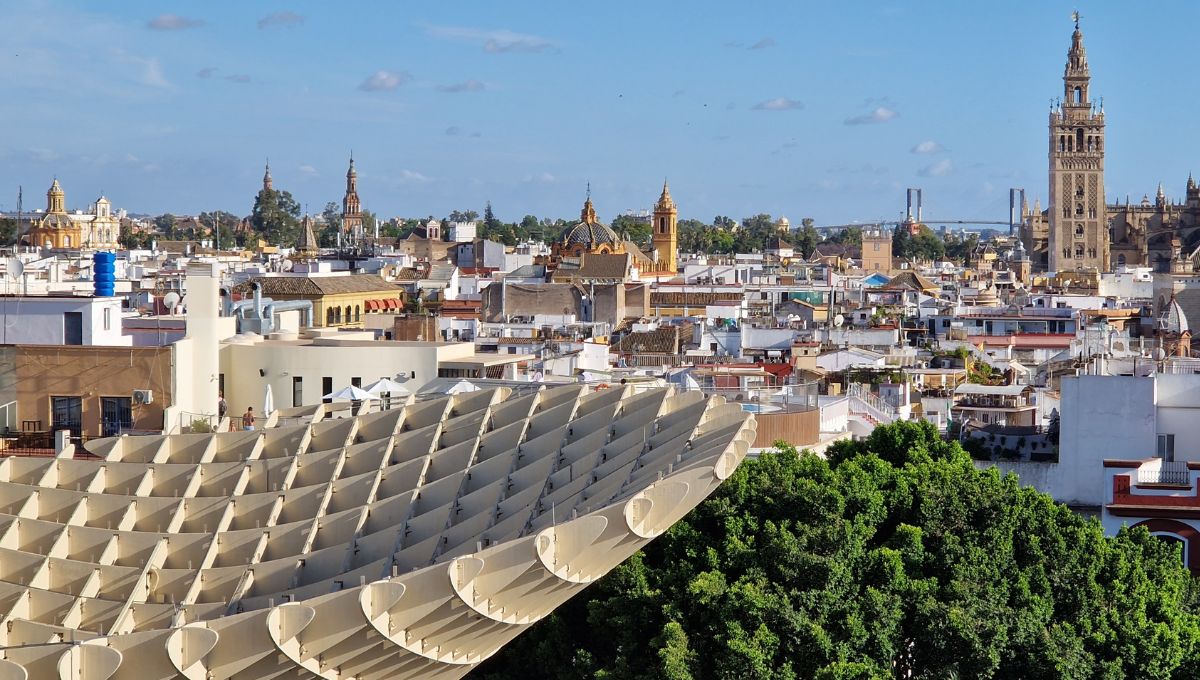
Beyond being the world’s largest wooden structure, the Metropol Parasol also boasts a small archaeological museum, a regular farmers market, and a panoramic terrace – all adding to its allure.
Whether you appreciate modern architecture or love a great view, there’s something here for you.
- Opening hours & Price: Monday to Sunday from 09:30 to 00:30 hs., final access at 23.30 p.m.
- Price to enter: Adults €15, children from 6 – 14 years od, €12, under 5 free
- See more info on their website.
3. Culture Vulture at the Museo de Bellas Artes

For art enthusiasts and culture vultures alike, enjoying the prestigious Museo de Bellas Artes when you visit Seville is a must. It ranks as one of the top museums in Seville that I have enjoyed exploring.
Nestled within the sacred confines of a repurposed convent, the Museo de Bellas Artes is much more than your average museum. It is a living, breathing testament to Seville’s rich artistic past, a veritable time capsule that transports you back to bygone eras. Here, you’re not just observing art; you’re stepping into the heart of Seville’s cultural heritage.
The museum’s extensive collection offers a comprehensive view of Seville’s artistic evolution. It features an impressive array of religious artwork, each echoing the profound faith deeply ingrained in the city’s history. Detailed and expressive portraits feature prominently in the collection, offering intimate glimpses into the everyday life of Sevillians from different epochs.
Notable among these are the works of legendary Spanish artists like Velázquez, Zurbarán, and Murillo. Their masterpieces form a significant part of the museum’s collection, infusing it with their unique styles and perspectives and underscoring the city’s rich artistic heritage.
The Museo de Bellas Artes operates under specific opening times. (Insert opening times here). It charges a nominal fee for entry (Insert entry fee here), which is worth every penny considering the wealth of artistic treasures it houses. These details, however, are subject to change, and it is advisable to check the museum’s official website before planning your visit.
- Opening times: Tuesday to Saturday from 09:00 to 21:00 with the exception of August when they close at 3 p.m. Sundays and holidays from 09:00 to 15:00. Closed Mondays
- Price: Price 1.50 euros. Free: for accredited European Union citizens and ICOM members.
- See more info on their website.
4. Explore Seville’s Rich Heritage with a free Seville walking tour
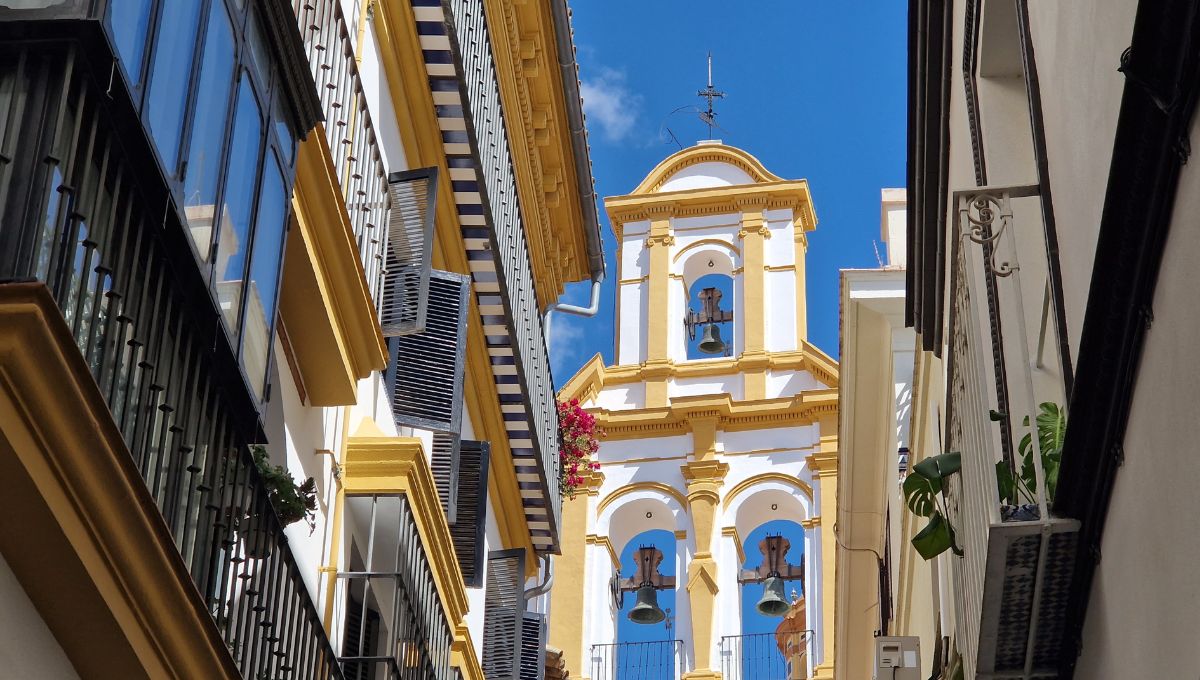
This is a must if you want free things to do in Seville. Think of free walking tours as your magical keys to unlock a treasure trove of wonders. These tours guide you through some of the city’s most renowned landmarks and introduce you to delightful hidden gems and often-overlooked historical sites. It’s your perfect opportunity to immerse yourself in Seville’s rich history and vibrant culture.
The free walking tours in Seville start in Plaza del Salvador, standing next to the statue. From there, you will discover numerous city highlights, including:
- The façade of the Church of the Divine Saviour.
- Plaza Nueva, where the City Hall and a monument dedicated to Fernando III to learn about the eras of Al-Andalus and the Reconquista.
- Plaza del Triunfo
- Seville Cathedral and Giralda bell tower
- The Royal Alcazar
- The Royal Tobacco Factory
- Plaza de España and Luisa Park
I love starting a visit to any city with one of these tours to get my bearings and whet my appetite for discovery.
5. Soak in the Atmosphere in the Triana neighbourhood

Seville can be likened to a beautifully composed symphony, and the Triana neighbourhood is unquestionably its most captivating melody. This district is globally renowned for its intricate ceramics, colourful tiles, and soulful music, making Triana a place where art and life seamlessly blend together and one of the top free things to do in Seville.
Known as the cradle of flamenco, the passionate and powerful dance that symbolises the spirit of Seville, Triana is where the soul of this enthralling traditional dance has its roots.
As you wander through this neighbourhood’s lively, narrow streets, you’ll likely be drawn in by the captivating sounds of a guitar’s strumming or spontaneous foot-tapping that echo from the open windows of the traditional buildings. This flamenco ambience is particularly more palpable during the summer months when locals and tourists alike fill the streets to enjoy the cultural spectacle.

A visit to Triana would only be complete with a stop at the bustling Triana Market. Here, you can soak up the local atmosphere while shopping for locally made goodies, from fresh produce to handmade souvenirs. The market is a vibrant hub of activity, and often hosts live music performances.
Mercado de Triana is open: Sun – Sun 12:00 PM – 5:00 PM; Mon – Sat 9:00 AM – 12:00 AM
Triana is also known for its vibrant nightlife and being home to some of the best tapas in Seville. The neighbourhood has numerous bars and restaurants where you can savour traditional Andalusian cuisine. The prices vary, but you can expect to pay around €10 – €15 for a main dish, less for smaller tapas plates.
Whether you’re an art enthusiast, a history buff, or a food lover, Triana has something to offer everyone. Its lively atmosphere, rich history, and vibrant culture make it a must-visit neighbourhood in Seville.
6. Uncover the past with the Spanish museum and houses in Castillo de San Jorge
Immerse yourself in a journey into the history of Seville at the Inquisition Museum, situated within the enthralling ruins of Castillo de San Jorge. Once a formidable medieval fortification along the riverfront, this location served as the headquarters for the Spanish Inquisition. This notorious period left an indelible mark on the city’s past.
The fortress of Castillo de San Jorge, with its centuries-old walls and towers, was a significant centre of power during the Middle Ages and a symbol of the city’s defence. Here, the Spanish Inquisition, one of the most controversial institutions in world history, held its trials and tribunals. This period was characterised by religious persecution and torture.
However, today, an entirely different atmosphere prevails within its walls. Castillo de San Jorge has been given a new lease on life, opening its doors to the public as a museum. It invites locals and tourists alike to explore Spain’s past and learn about its history.
The museum houses a fascinating collection of art and informative displays, providing insights into the different eras of Spanish history. It offers a unique opportunity to traverse the corridors of time and experience history firsthand.
Wandering through the remnants of this historic fortress is akin to stepping into the pages of a history book, allowing visitors to visually and mentally connect with the past. Amidst the preserved ruins, one can almost hear the echoes of the past and feel the weight of history that this place holds.
The Museum of Castillo de San Jorge is open daily during the week from 11 a.m. to 6:30 p.m. and from 10 a.m. to 3 p.m. weekends and holidays and entrance is free.
7. Visit the iconic Real Alcazar of Sevilla
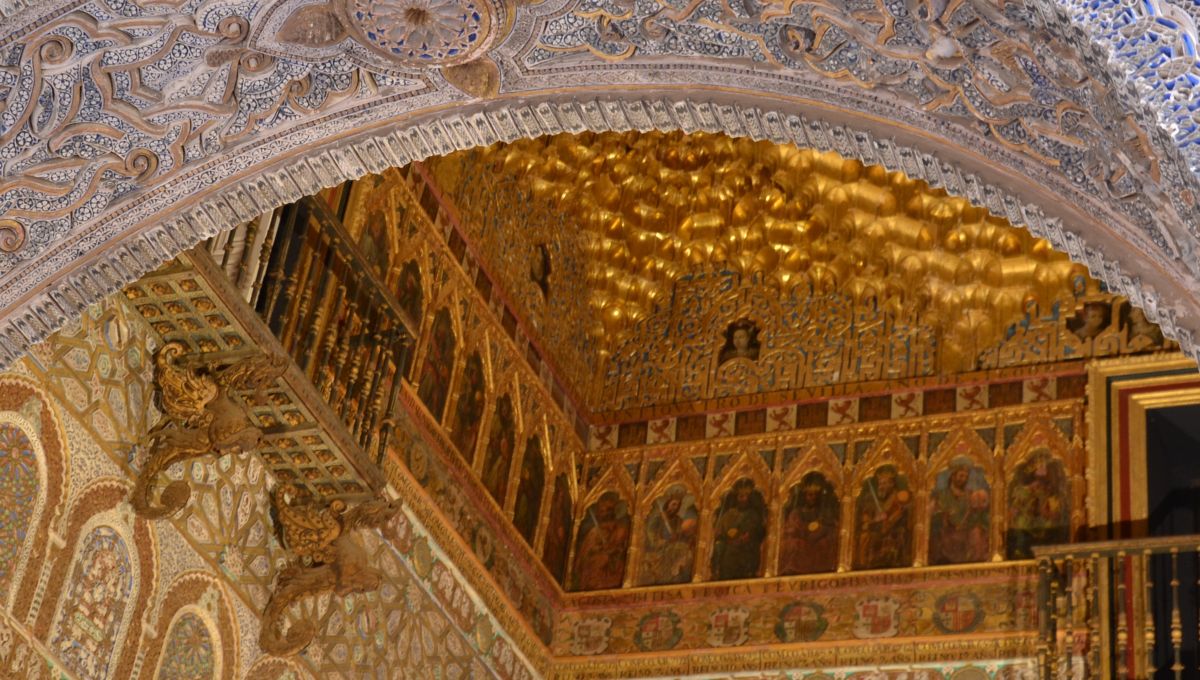
With well-planned timing, you can experience the most popular place to visit in Seville without any cost. The Real Alcazar of Seville stands as a living testament to the passage of time, serving as a royal residence for centuries, echoing the grandeur of its past.
Located in the thriving Barrio Santa Cruz (also known as the Jewish Quarter), the palace’s history dates back to the tenth century, marked by multiple rulers who contributed to its architectural grandeur.
Its rich history and beautiful architecture make it a must-visit destination for history buffs and architecture enthusiasts.
Today, the Real Alcazar is the oldest royal palace still in use on the European continent. It continues to serve as a royal residence whenever the Spanish royal family graces Seville with their presence.
Every corner of the palace, from its lavishly decorated rooms to its verdant gardens, tells stories of royalty and splendour.
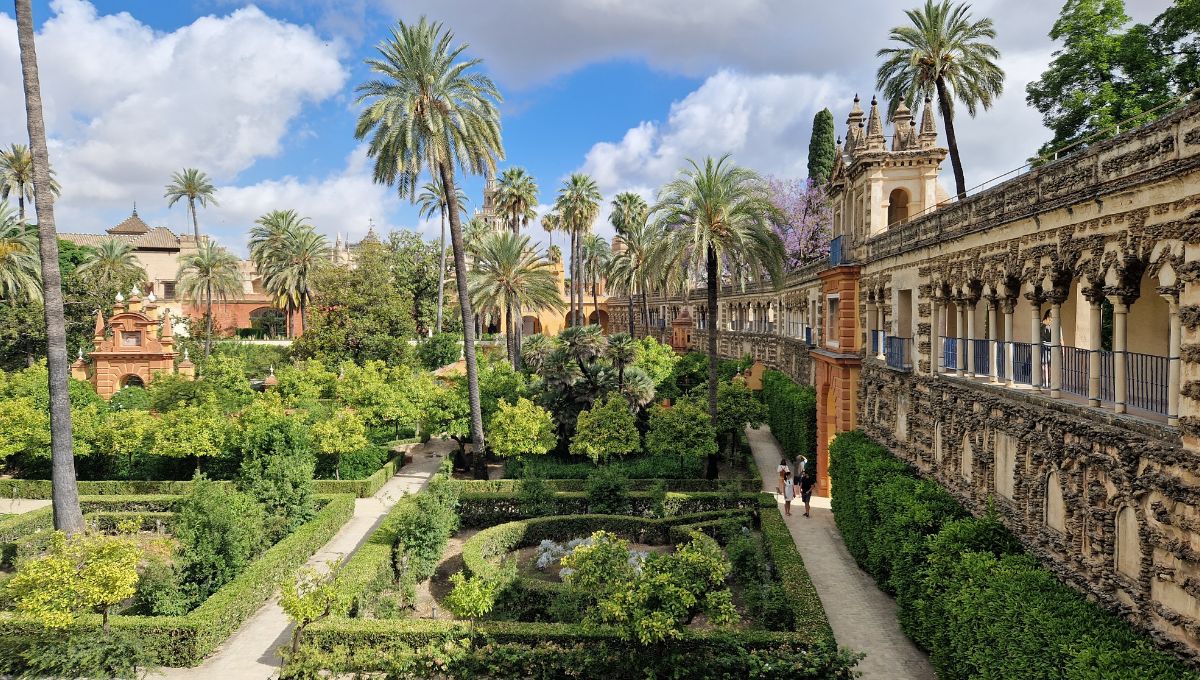
Moreover, the Real Alcazar has also been used as a filming location, notably serving as a backdrop for Dorne in the popular television series Game of Thrones. This has added another layer of fascination to the palace, attracting fans of the series worldwide.
One of the best times to visit is on a Monday afternoon when the palace offers free entry, allowing visitors to marvel at this magnificent spectacle without cost. (Placeholder for specific opening hours).
In addition to its free entry on Monday afternoons, the palace offers different ticket options depending on the visitor’s preference.
Alcazar of Seville opening hours & prices
- From October 29 to March 31: Monday to Sunday, 09:30 to 17:00. (closing at 18.00)
- From April 1 to October 28: Monday to Sunday, 09:30 to 19:00. (closing at 20.00)
- Price: General entry €13.50, include dmission to visit the Royal Bedroom, add €5.50
- Monday from 18:00 to 19:00. From April to September, and from 16:00 to 17:00 from October to March: Free.
8. Discover the City’s Roman roots

Seville holds a rich tapestry of stories from the Roman era. Historically known as Hispalis during the reign of the Romans, the city was a pivotal point in the vast Roman Empire.
This period of rule has left an indelible mark on the city, with the most notable evidence being the ruins of the Roman aqueduct, Caos de la Carmona. These remarkable ruins are a testament to the grandeur of Roman architecture and a symbol of Seville’s historic past.
Situated just 9 kilometres outside of Seville is the quaint village of Santiponce. This village is significant in Roman history as it was the birthplace of two influential Roman Emperors, Trajan and Hadrian. The village is also home to beautifully preserved mosaics that once graced the floors of opulent Roman villas. These intricate artworks provide a glimpse into the Romans’ artistic prowess and appreciation for elaborate designs.
In addition to the above, Seville and its surrounding areas are known for other Roman architectural marvels, from amphitheatres to temple ruins. Each site provides a fascinating insight into the Roman way of life and their architectural brilliance.
9. Stroll along the Guadalquivir River and Torre del Oro
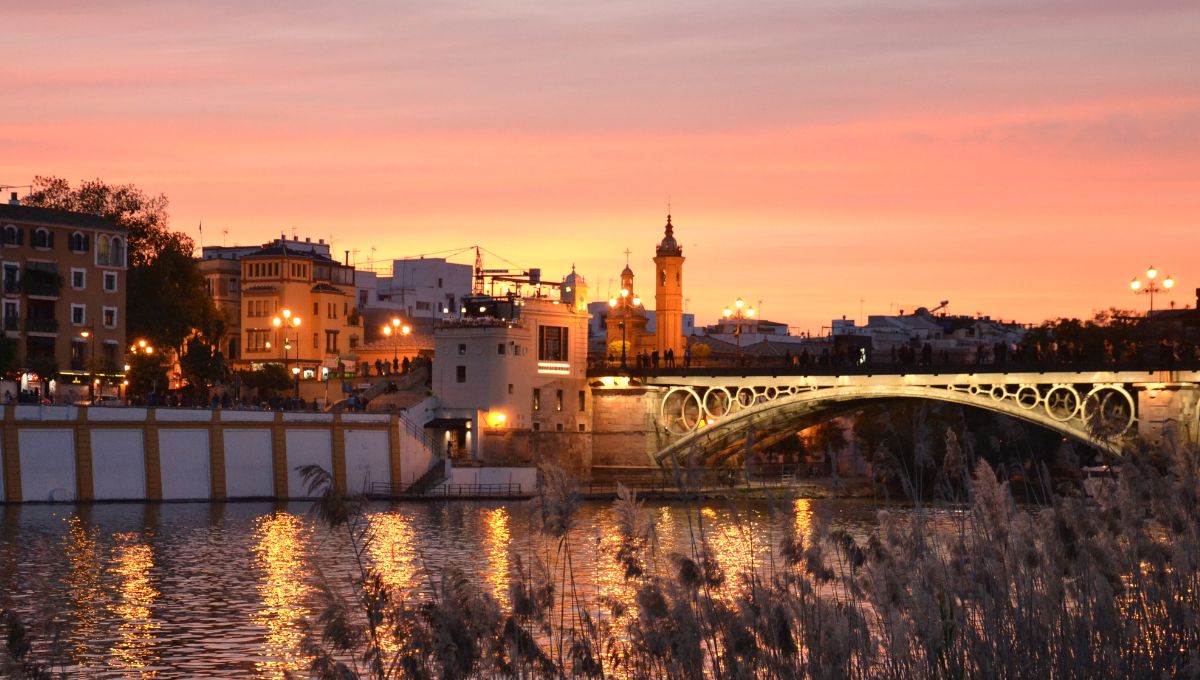
As the day’s heat recedes and a refreshing breeze picks up, the banks of the Guadalquivir River, one of the important historical waterways in Spain, become the perfect setting for a relaxing evening stroll.
Walking along the riverbank, you’ll notice a refreshing breeze that whispers tales of the past and soothes your soul, creating a serene ambience that is hard to resist. This makes it the perfect spot to unwind after a long day of exploration.
If you have some change left over, I recommend the mojitos from the chiringuito close to the Muelle de la Sal. Here, you can indulge yourself while the spectacular Seville sunset paints the sky with its golden hues, casting a mesmerising reflection over the river’s calm waters.

The iconic Torre del Oro stands just a short distance away, overlooking the river. This 13th-century watchtower, with its dodecagonal military structure, has been a silent spectator to Seville’s ever-evolving history. The tower, which once served as a prison during the Middle Ages, is now a naval museum showcasing the maritime history of Seville.
So, whether you’re a history enthusiast, a food lover, or looking for a peaceful spot to unwind, a stroll along the Guadalquivir River and a visit to the Torre del Oro should be on your Seville itinerary.
10. Cathedral and Giralda Tower

Dominating the historical centre of Seville, the Cathedral and Giralda Tower are a testament to the city’s rich spiritual and architectural history. This iconic landmark is not just a place of worship but a symbol of Seville’s indomitable spirit and the final resting place of many prominent figures, including Christopher Columbus.
A free tour of Seville Cathedral, including an audio guide and access to the La Giralda Tower, is available Mondays from 4:30 p.m. to 6:00 p.m. A limited number of free tickets are available between 2 p.m. and 3 p.m. from Monday to Friday.
Take this chance to ascend the Giralda Tower and gaze at the city that stretches below.
Within the sacred confines of the Cathedral, there are numerous tombs of noteworthy individuals. Among these is the final resting place of the world-renowned explorer Christopher Colombus, a point of interest for many visitors. Other tombs belong to kings, cardinals, and other important figures in Spanish history.
FAQ
What are some free things to do when I visit Seville?
Seville is a city full of attractions that are always free to explore. You can walk around the Santa Cruz neighborhood, the old Jewish quarter of Santa Cruz. You can get free entrance to sites like the Maria Luisa Park and Mercado de Triana. Museums like the Macarena or Alcázar are often free on certain days of the week, so make sure to check ahead!
I’ve heard flamenco originated in Sevilla. Where can I experience this?
Absolutely, Seville is known to be the birthplace of flamenco. You can see several authentic flamenco shows which are free on certain days. Some top things to do include visiting venues in the Santa Cruz district and the Triana neighborhood, where many shows are free. It’s definitely worth a visit.
I’m looking for things to do in Seville on a Monday. What’s free to enter on this day?
On Mondays, some of Seville’s museums are free to enter! This includes the Alcázar and the Casa de Pilatos. Just make sure to verify the hours in case there are any changes.
What are some of the must-visit non-touristy spots in Seville?
If you’re looking for places where the locals go, the Mercado de Triana is one of the best places to visit. It’s always free to enter and you’ll find it in the vibrant Triana district. Also, exploring the Parque de Maria Luisa and the courtyards of the Santa Cruz district can give you a taste of the local flavor.
Is there anything special about the Iglesia Colegial del Divino in Seville?
The Iglesia Colegial del Divino is a stunning church in Seville. It’s known for its beautiful architecture and for hosting flamenco shows. It is free to enter and is definitely worth a visit when you’re in Seville.
Is the Cathedral in Seville free to visit?
The Seville Cathedral, also known as the Cathedral of Saint Mary of the See, is actually the largest Gothic cathedral in the world. While it is not always free to enter, it offers free entrance on certain days of the week, usually Mondays. It is one of the landmarks you should not miss when you visit Seville.
Final thoughts
I hope you have found some inspiration in my list of cheap and the best free attractions in Seville so you can make the most out of your journey.
Seville’s historic district is relatively small. All the major sites are easily walkable if you stay in the city. Seville’s public transportation is perfect and cheap. There is a vast bus network that the regional operator, TUSSAM, manages.
Tickets are affordable and can be bought on board. Getting a travel card could be worthwhile if you plan to remain for a few days.

About the author
Matthew is a seasoned traveller and founder of The Travel Blogs, where he shares his passion for exploring the world with more than 20 years of globetrotting experience behind him and more to come! Currently living in Madrid, Spain, he loves to discover new places with his young family across Spain and Portugal while still including regular trips to far-flung destinations. Don’t forget to follow The Travel Blogs on Facebook and YouTube for even more inspiration and tips!
